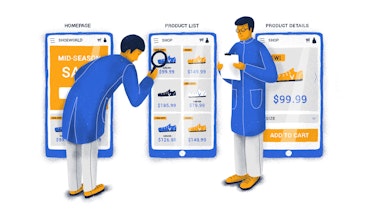Communicating with designers isn’t necessarily that straightforward as it may seem—and there are multiple reasons for that. UX specialists work with an extremely specific part of a product, and while satisfying business needs is part of their responsibilities, their focus revolves around user behavior.
Designers craft experiences by leveraging an entire arsenal of pretty occult rules and principles that stem from psychology, sociology, human-computer interaction, and a variety of other disciplines. As a result, when developers, project managers, and even C-suite officers provide them with feedback, an array of misunderstandings may arise.
This article is a quick guide towards more effective and frictionless communication with designers for non-designers.
Let’s jump into it.
Involve designers as early as possible
A common mistake businesses make is not involving UX designers early in the development process. By leaving these specialists out, companies are opening themselves out to a product that might fail to meet user needs, which is pretty much synonymous with failure.
Furthermore, it’s vital to create an environment where designers will feel like a valuable part of the product and, ideally, have a sense of ownership. Instead of just shipping your ideas to designers and having them work in a vacuum, ensure that you’ll have their input at the earliest stages of the development process—you might be (and probably are) missing out on some crucial insight into your product.
Thinking of designers as people that “need to step in and do the stuff” causes a pretty widespread scenario that most UX specialists have been part of more times than they’d please: “Hey, uh, I’ve designed the app myself, and I need someone to ‘do the UX’ for me.
In order to ensure a product’s superior user experience, it’s imperative to understand how designers work and what the UX design process looks like, which brings us to our next tip.
Take some time to understand the process
To understand how designers work, it’s imperative to have a good grasp of the fundamentals of the discipline itself. This will invariably allow you to see the big picture, even though it may seem like there’s no immediate value to it.
UX specialists conduct a wide array of activities like discovery workshops, user research, and usability testing that are meant to yield informative insights about users and the optimal parameters of the product. It would be a huge waste not to take in this information rather than leaving it within the confines of the designer team.
Furthermore, the UX design process allows companies to take a very in-depth look at who users are, as well as understand more about their fears, preferences, and aspirations. Businesses are naturally driven to maximize profits and touch success milestones, but doing so without investing time and effort to learn about and empathize with your users is merely impossible.
Don’t cut corners
Assuming that you’ve invested some time to better understand the UX design process, it’s crucial to underline that cutting corners is not an option if you’re looking to have a well-thought-out product and avoid spending a bunch of money on fixing bugs.
Let’s put it this way: if you’re knowingly trying to cut corners in the UX design process, you’re deliberately sabotaging the success of your project. We know this may seem dramatic to some, but we’ve seen this happen an uncountable number of times.
Yes, things like budget or time constraints might dictate your priorities. However, experienced designers can create a “good enough” product even in those conditions. Whatever you do, make sure to communicate these constraints to your crew of designers so you can find a common denominator.
Provide quality feedback
Probably one of the most important things you should take into account when providing designers with feedback is context. Any suggestions should be made with goals and metrics in mind. If the context is left out, it can and probably will be misconstrued as personal opinion, which is by no means helpful in design.
Avoid phrases like “I don’t like it” or “It just doesn’t pop”— this is not quality feedback. At the same time, never be dissuaded from voicing your design-related concerns. However, it’s essential to be visual when conveying some ideas or feedback. Consider using a pen and paper to sketch out the things you’re looking to change or discuss. Rest assured, nobody’s going to criticize your drawing skills.😄
Leave your ego at the door
“I’ve been in the business for over twenty years. Trust me, I know better.” How would you feel if you were presented with this kind of argument? Designers won’t appreciate it either.
More importantly, one of the fundamental tenets of UX design states that “You are not your user." Therefore, the users should be the ultimate judges of design, not clients — this is how UX designers validate their decisions. At the end of the day, they won’t mind following your recommendations, but fundamentally, it won’t benefit anyone but your own ego.
The bottom line
Communication ain’t easy. Efficient communication is even harder.
When discussing work with designers, it’s essential to take their professional principles into account. UX design is a very complex, interdisciplinary practice, and it’s crucial to consider that when providing feedback to user experience professionals.




